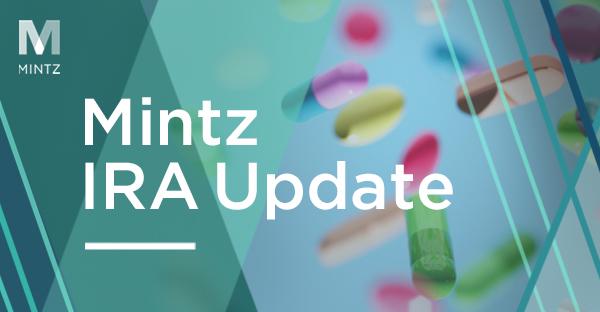Mintz IRA Update — Learning From Experience: Medicare Drug Price Negotiation Program Updates
Since our last edition of the Mintz IRA Update, the Medicare Drug Price Negotiation Program (the “Negotiation Program” or “Program”) and related maximum fair price (MFP) negotiation process for each of the 10 high-expenditure Medicare Part D drugs selected for negotiation (the “Selected Drugs”) has gone into full swing. After the Centers for Medicare and Medicaid Services (CMS) sent initial offers to the manufacturers participating in the first cycle of the Negotiation Program, the Biden administration confirmed that it had received counteroffers from each of the Selected Drugs’ manufacturers. The Biden administration later confirmed in April that it had sent subsequent counteroffers to manufacturers for the Selected Drugs. Pursuant to the Draft Guidance for Initial Price Applicability Year 2027 and Manufacturer Effectuation of the MFP in 2026 and 2027 (the Draft Guidance), each manufacturer may meet with CMS up to three times to further negotiate the MFP before CMS announces the final MFP for each Selected Drug on September 1, 2024.
Despite an initial outcry from many manufacturers, including litigation challenging the program filed in six judicial circuits, some manufacturers have since conceded that the negotiations have not proven to be as disparaging to their businesses as anticipated, which we discuss further below. Nevertheless, as we detail in this article, CMS is already considering changing the structure and format of the negotiation meetings for 2027.
Changes to the 2027 Negotiation Process and Potential Drugs for Selection
CMS released the Draft Guidance on May 3, 2024. CMS outlined new requirements for the second cycle of negotiations, which begin in 2025 and will result in negotiated MFPs that go into effect in 2027.
A key focus under the Draft Guidance is CMS’s invitation for public comment regarding how CMS may change the format and number of negotiation meetings with manufacturers. Currently, CMS invites manufacturers to meet up to three times to negotiate the MFP for a Selected Drug before CMS announces a final price. However, as the number of drugs selected for negotiation increases each year (e.g., 15 additional Part D drugs in 2027, and an additional 15 Part B and/or Part D drugs in 2028), CMS acknowledges that holding three meetings for each drug selected for negotiation will prove overly burdensome and difficult to schedule.
Some additional updates to the Negotiation Program since publication of the Revised Guidance for Initial Price Applicability Year 2026 (the “Initial Guidance”) include:
- Changes to the requirements and parameters for data exchange among dispensing entities (e.g., pharmacies) and participating manufacturers via a Medicare Transaction Facilitator (MTF) to provide data needed to facilitate access to MFPs of Selected Drugs for dispensing entities;
- Use of an MTF to facilitate the provision of claim-level data elements to manufacturers when a Selected Drug is dispensed to a person verified to be MFP-eligible;
- Requirement that participating manufacturers must make the MFP available at the point of sale to MFP-eligible individuals (and dispensing entities with respect to such MFP-eligible individuals) who are dispensed that Selected Drug during a price applicability period; and
- Proposed changes to the process and format for the MFP offer and counteroffer process between CMS and manufacturers, such as replacing one or more of the meetings with a written offer.
Response to Draft Guidance Across Industry
CMS solicited public comment and feedback on the Draft Guidance, with comments due to CMS by July 2, 2024. According to an article from Endpoints News, the Draft Guidance has received negative feedback from various pharmacy supply chain stakeholders for a lack of transparency.
Representatives from trade associations PhRMA and BIO have reported that they found certain aspects of the Draft Guidance — specifically the proposal to reduce the format and number of industry-CMS negotiation meetings — to be an attempt by CMS to limit opportunities for manufacturer input with respect to the negotiation of the MFP. According to the trade associations’ representatives, the Draft Guidance fails to address patient and provider concerns regarding the process through which CMS sets prices and how information gathered by negotiation meetings with manufacturers will be utilized. Representatives also found that the Draft Guidance did not address concerns offered in public comments to the Initial Guidance, in which many commenters were wary that price negotiations, combined with changes in interested party liability following a redesign of Part D, could impact the structure of Part D and in turn decrease patient access to medications.
Additionally, the American Hospital Association (AHA) submitted a letter to CMS on July 2, 2024, expressing concern over CMS’s proposal to retrospectively effectuate the negotiated MFP by permitting manufacturers to make the MFP available to dispensing entities by retrospectively reimbursing the dispensing entity for the
difference between the entity’s acquisition cost and the MFP. The AHA claimed the proposed retrospective refund process would be “complex, burdensome, and would be operationally unworkable with respect to the critical 340B Drug Pricing Program” and expressed concern that the proposal would cause providers to have to chase down rebates and 340B discounts from manufacturers instead of requiring manufacturers to make the negotiated MFP available upfront, which is consistent with how the 340B program currently operates.
Drug Manufacturers Change Perspective on the IRA’s Impact
Despite their frustration with the Draft Guidance, manufacturers have begun to concede that the Negotiation Program may not have as drastic of an impact as initially anticipated. In a 2023 interview, Pfizer’s CEO initially described the Negotiation Program as “negotiation with a gun to your head.” Recently, however, Pfizer’s CFO acknowledged that “the impact of the IRA over time would be modest” given that many of its products that are “at risk [of being subject to the Negotiation Program] in the near term” are nearing the end of their marketing exclusivity period. Once the exclusivity periods end, generic competitors are likely to enter the market and drive down the prices for those same drugs; therefore, Pfizer already anticipates lower profit margins from these drugs. Similarly, AstraZeneca, one of nearly a dozen manufacturers to file a lawsuit against the government for IRA price negotiations, has since revealed that CMS’s first offer for its diabetes medication, Farxiga, was “relatively encouraging.” The public is not privy to the exact prices discussed during the negotiations, but some patient groups suspect the recent statements by manufacturers may be an attempt by corporate executives to stem market concerns about the financial impacts of the Negotiation Program and protect the manufacturers’ share value. However, Leigh Purvis, prescription drug policy principal at AARP’s Public Policy Institute, believes CMS may be offering reasonable prices for the Selected Drugs, and manufacturers recognize the importance of conceding early to maintain their reputation with the public. If CMS ultimately decides upon reasonable MFPs for the Selected Drugs, manufacturers who continue to claim they will be significantly financially harmed by the Negotiation Program may lose their credibility and influence on public opinion.
Whatever the reason for the manufacturers’ change of tone with regard to the Negotiation Program, drug affordability advocates assert that research supports reduced premiums and out-of-pocket costs for MFP-eligible individuals and the federal government can still expect to see significant savings over the next few years.




